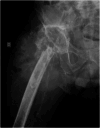High-grade Pleomorphic Sarcoma Associated with Metallosis in a Patient with Total Hip Arthroplasty
- PMID: 39027180
- PMCID: PMC11254430
- DOI: 10.1055/s-0041-1735140
High-grade Pleomorphic Sarcoma Associated with Metallosis in a Patient with Total Hip Arthroplasty
Abstract
Although the relationship between hip arthroplasty and the development of sarcoma was first described in the literature about forty years ago, this association is extremely rare. In the present case report, we describe the association between orthopedic implants and soft tissue sarcoma in a 79-year-old man who underwent primary total hip arthroplasty (THA) for coxarthrosis 24 years ago. In the present case report, we describe the clinical evolution and the radiographic and histopathological findings of the lesion. In the intraoperative period of the second revision surgery, loosening of the acetabular and femoral components in association with extensive areas of necrosis and metallosis was evidenced. We performed debridement of the hip and right thigh region and removed the implants. Due to the extent of the lesion and to necrosis, it was not possible to perform a new joint reconstruction. The histopathological diagnosis of high-grade undifferentiated pleomorphic sarcoma associated with extensive areas of metallosis was confirmed in tissue adjacent to the implant. The patient developed pulmonary metastases and died 6 months after the diagnosis. Despite the rarity of this association, sarcomas should be considered in the differential diagnosis of aseptic loosening, especially in the presence of metallosis in the peri-implant tissue. To our knowledge, the 24-year latency period between primary THA and the establishment of a sarcoma diagnosis is one of the longest reported to date.
Keywords: arthroplasty, replacement, hip; hip prosthesis; metals; sarcoma.
The Author(s). This is an open access article published by Thieme under the terms of the Creative Commons Attribution 4.0 International License, permitting copying and reproduction so long as the original work is given appropriate credit ( https://creativecommons.org/licenses/by/4.0/ ).
Conflict of interest statement
Conflito de Interesses Os autores declaram não haver conflito de interesses.
Figures








References
-
- Purdue P E, Koulouvaris P, Potter H G, Nestor B J, Sculco T P. The cellular and molecular biology of periprosthetic osteolysis. Clin Orthop Relat Res. 2007;454(454):251–261. - PubMed
-
- Bagó-Granell J, Aguirre-Canyadell M, Nardi J, Tallada N. Malignant fibrous histiocytoma of bone at the site of a total hip arthroplasty. A case report. J Bone Joint Surg Br. 1984;66(01):38–40. - PubMed
-
- Visuri T, Pulkkinen P, Paavolainen P. Malignant tumors at the site of total hip prosthesis. Analytic review of 46 cases. J Arthroplasty. 2006;21(03):311–323. - PubMed
-
- EUROCARE-5 Working Group . Stiller C A, Botta L, Brewster D H et al.Survival of adults with cancers of bone or soft tissue in Europe-Report from the EUROCARE-5 study. Cancer Epidemiol. 2018;56:146–153. - PubMed
-
- Lamovec J, Zidar A, Cucek-Plenicar M. Synovial sarcoma associated with total hip replacement. A case report. J Bone Joint Surg Am. 1988;70(10):1558–1560. - PubMed
LinkOut - more resources
Full Text Sources

